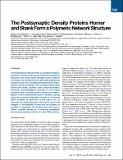The Postsynaptic Density Proteins Homer and Shank Form a Polymeric Network Structure
Author(s)
Hayashi, Mariko Kato; Tang, Chunyan; Verpelli, Chiara; Narayanan, Radhakrishnan; Stearns, Marissa H.; Xu, Rui-Ming; Li, Huilin; Sala, Carlo; Hayashi, Yasunori; ... Show more Show less
DownloadHayashi-2009-The Postsynaptic Den.pdf (2.423Mb)
PUBLISHER_POLICY
Publisher Policy
Article is made available in accordance with the publisher's policy and may be subject to US copyright law. Please refer to the publisher's site for terms of use.
Terms of use
Metadata
Show full item recordAbstract
The postsynaptic density (PSD) is crucial for synaptic functions, but the molecular architecture retaining its structure and components remains elusive. Homer and Shank are among the most abundant scaffolding proteins in the PSD, working synergistically for maturation of dendritic spines. Here, we demonstrate that Homer and Shank, together, form a mesh-like matrix structure. Crystallographic analysis of this region revealed a pair of parallel dimeric coiled coils intercalated in a tail-to-tail fashion to form a tetramer, giving rise to the unique configuration of a pair of N-terminal EVH1 domains at each end of the coiled coil. In neurons, the tetramerization is required for structural integrity of the dendritic spines and recruitment of proteins to synapses. We propose that the Homer-Shank complex serves as a structural framework and as an assembly platform for other PSD proteins.
Date issued
2009-04Department
Massachusetts Institute of Technology. Department of Brain and Cognitive Sciences; Picower Institute for Learning and Memory; RIKEN-MIT Center for Neural Circuit GeneticsJournal
Cell
Publisher
Elsevier
Citation
Hayashi, Mariko Kato, Chunyan Tang, Chiara Verpelli, Radhakrishnan Narayanan, Marissa H. Stearns, Rui-Ming Xu, Huilin Li, Carlo Sala, and Yasunori Hayashi. “The Postsynaptic Density Proteins Homer and Shank Form a Polymeric Network Structure.” Cell 137, no. 1 (April 2009): 159–171. © 2009 Elsevier Inc.
Version: Final published version
ISSN
00928674
1097-4172